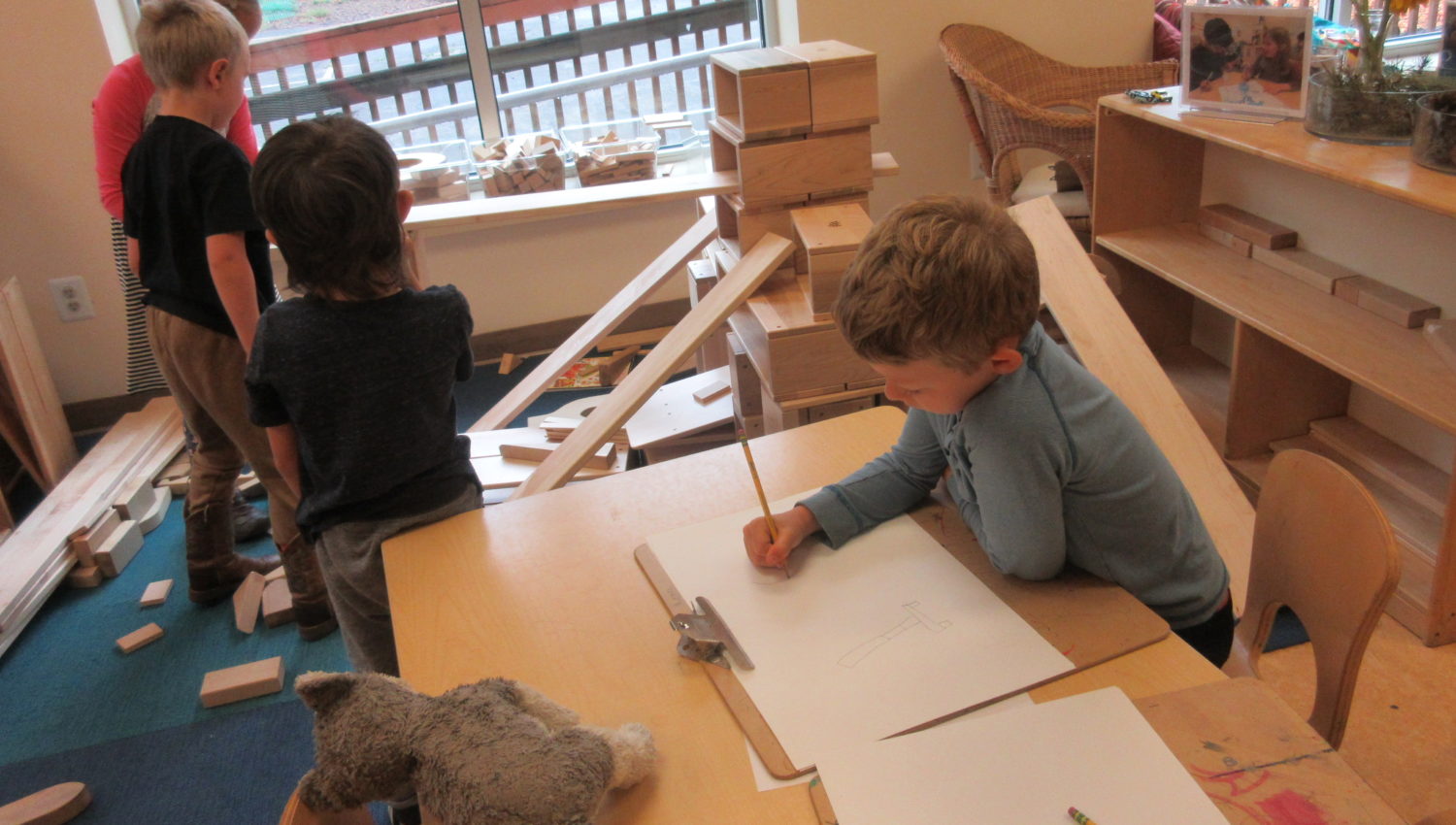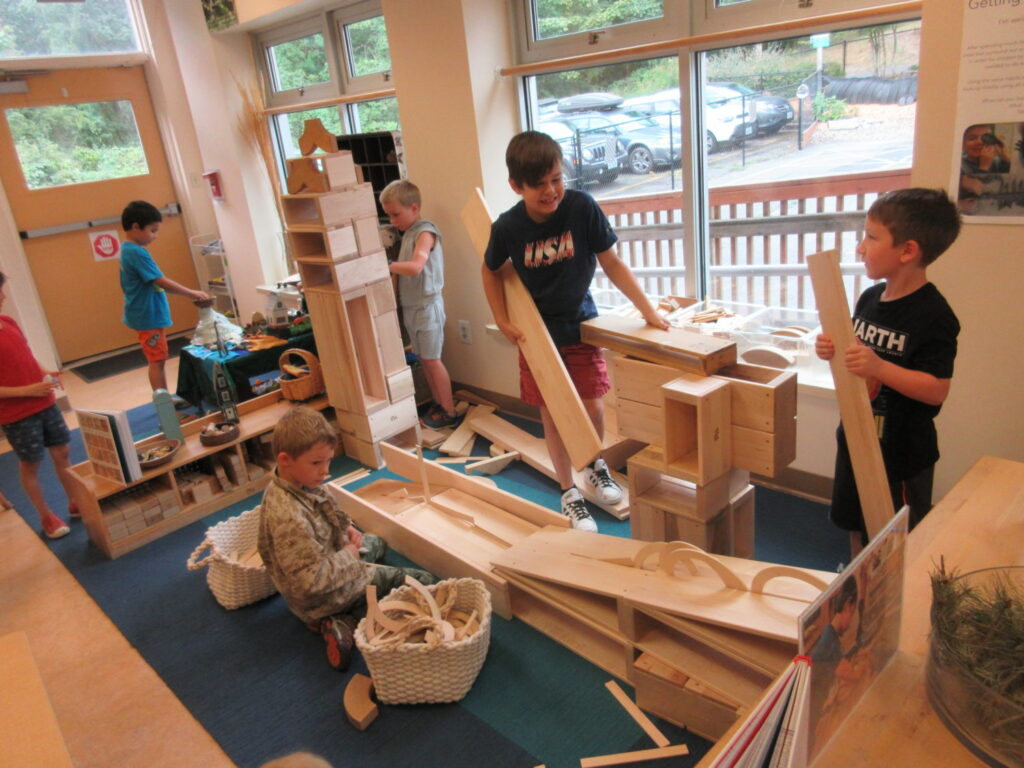Blocks (and unblocking)

This year, the Primary Team is framing their intentions through a study of self. During the first week of school, teachers set intentions and committed to processes of observation, documentation, and reflection to open new questions and possibilities. During the first week of school, teachers wondered what provocations they might offer early on in the year that would help them uncover more about what these particular children cared about, were interested in, and curious about related to those intentions. Here is what one of the Primary teachers, Kye, said about the materials they planned to offer children during that first week of school.
My co-teacher and I feel confident that thinking about memory and how the senses, alongside materials, can awaken memories of summer will be work where we can see how our intentions align with the interests of these children. We also expected this would provide opportunities to connect and reconnect for returning and new students.
When the children arrived and were ready to go to Explore, we listened in as children found and connected over memories of fishing in the water tray, of swimming from the blue Sculpey, and of dreams they had through watercolor and a model of the human body. But reflection meeting seemed to clunk along, with many side conversations and interruptions about other ideas along the way. They weren’t inspired, yet.
Kye has experienced what it feels like when both teachers and children are engaged with big ideas together. There’s a certain kind of energy teachers are seeking that they noticed just wasn’t there yet. It’s early in the year, so they knew they just needed to toss another ball. As they looked back through their notes and reflected on where they had seen children’s interest being held, they noticed that a request for building had come up multiple times. The children had noticed early on that the big blocks weren’t open during Project Work. This was an intentional decision, made by the teachers, as they wanted more time to consider how building materials such as big blocks might support the intentions they had set.
Kye wondered,
How would we turn the ever popular and energetic interest in the block area into a provocation to explore the self?
On the day we opened the block area (which they had been begging to be opened) we still weren’t quite sure how it would fit – but it seemed worth it to see what would happen.
As always, something interesting (and very human) happened in the block area – and because the teachers were curious about the block area, we were already there, ready to ask questions and document.

As I observed, I wondered if the racetrack that the children were building needs to connect just like humans in a community need to connect. So, I framed my questions around that wondering:
Kye: What makes the racetrack work?
Phoenix: These blocks here.
Kye: The ramps?
Lewis: The parking garage is my favorite.
Phoenix (indignantly): We already have a parking garage!
Just as this conflict was brewing, another starts:
Lewis: Riley won’t let me do what I want.
Kye: Are you saying you want more control?
Lewis: No
Kye: Are you saying you want it to feel good?
Lewis: Yeah. I want him to let us do more stuff. What we want to do.
I ask him what he wants to do about this problem and he looks away. From afar a child exclaims, “Why is it so messy?!”
The energy is building to where it almost feels frenetic as conflicts arise and the children aren’t sure how to come together.
This moment as a teacher can feel extremely tricky to navigate. Kye decides they don’t have enough information and makes the decision to keep observing. The bumps and misfires continue.

Lewis: You’re not letting me do anything!
Riley: We need to take this board out.
They pull blocks out as an effort to get their way, and the systems and organization that made the racetrack “cool” (and connected) dismantle.
Charlie: Where’s my car?!
Riley: This doesn’t work! (takes a block out of Lewis’s hands)
Lewis: You’re so mean!
Phoenix: People keep taking the ramps!
Riley leaves the block area in tears, Phoenix decides to pick another station, and Lewis returns to building until Soren and Gabriel return to talk to Lewis: “You just need to go in there and listen to him!” They say. “Yeah, just listen!”
If you’ve ever been in the block area with a big group of children, you can probably picture this scene: the way the conflicts build and everything happens so fast, until the whole structure comes crashing down and everyone is left feeling frustrated. Maybe you’ve wondered, “What’s my role here?” Or “I should just close blocks, this isn’t working.” Or “Now what?!”
Kye could have made many different decisions in this moment. The uncertainty and vulnerability that both children and teachers are feeling in this moment is substantial. There is a tendency when things get messy for adults to want to step in and solve the problem for the children: to intervene with a new rule or a suggestion that everyone should try. Kye doesn’t do this. Although Kye wants to keep the children safe and wants to support the children to slow down and get more information from one another, Kye also knows (even when it feels hard) that conflicts such as these have the potential to teach both adults and children more about themselves, one another, and how they want to be together. This kind of learning is dependent on reflection- so Kye makes the decision to bring one of the conflicts from blocks back to the whole group during Reflection Meeting.
I start by telling them what I saw and what I heard, and since I didn’t get all the stories yet, I quickly get the story wrong myself. So, I ask a question:
Kye: Riley, what did I get wrong?
Riley: I wasn’t trying to be in control.
Kye: I am sorry I made an assumption because I heard one story and I didn’t check in to hear the other. Riley, what’s your story?
Riley: That person was trying to be in control, not me.
Lewis: I wasn’t!
Riley: You didn’t like it when I assumed your story.
Kye: What did you want?
Riley: I just wanted someone to stop.. Just stop…just stop everything and just…have a check in
Kye: Slow down?
Riley: Yeah.
Teachers write this term down, and the children agree that they, too, want a community that holds that value in place. Then, it’s Lewis’s turn to share his story. I remind them that we might need all the stories to make sense of it.
Lewis: It felt like somebody was telling me what to do.
Kye: What do you wish had happened?
Lewis: Tear the tower down and make a new one!
Lots of disagreements come from the community.
Someone asks, “Who would do that?!”
Soren: I would do that! If you knock down you can improve it and make it cooler and improve your ideas and make different things!
Many of the children who had previously disagreed quickly change and fall into this reasoning.
Shawn: You could make it even bigger!
Riley: Yeah, we could!
Dillon: I can help! I’m going to knock it down right now!
With a reminder of the intention they had just set to have a community that remembers to slow down, they make a plan to make a plan during snack for the kind of structure they’d like, and simultaneously, begin to build not just a bigger and cooler ramp, but also open a door into thinking about the kind of community they want to become.
In this moment of reflection, I see the feelings of vulnerability and uncertainty that still remain, but I also see the opportunity it provides to practice habits of mind like curiosity and perspective-taking, while helping everyone see that they have the power to rewrite this story. To me, this was an opportunity for all of the children in this community to feel a sense agency and have ownership over the outcome of this conflict. And in doing so, the teachers begin to communicate messages about who they believe this particular group of children to be and what they believe they are capable of.
This whole experience is rich with opportunity and I think we found it not only through letting the children play, but also by not letting go of our intentions, ensuring that we knew were looking for the moments where theirs aligned with ours.
After this moment, I’m left wondering:
What conditions support children to open up about what they truly believe and what they’re experiencing in order to make agreements from a place of authenticity?
How do we develop a culture of curiosity, ensuring that all ideas get questioned, without shutting anyone down?
How do I respond with curiosity – especially when my own beliefs are challenged or not aligned with what someone else says?
What does it take for a diverse group of people with lots of different ideas to come together –to feel heard and not stepped on, to be assertive with their voice but not aggressive or passive?
How can we all say what we need, disagree, and still come to consensus on how we want to be together?
Reader, what does your process of reflection look like? What happens when you set an intention, observe and document what happens, and reflect on what you noticed? What new questions emerge for you? What new possibilities?
